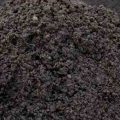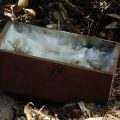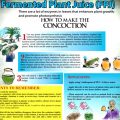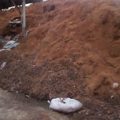Developed by a group of scientists from the Sugar Regulatory Administration (SRA), the technology uses sugarcane by-products like bagasse, mudpress, slops and ash from sugar factories and alcohol distilleries. Bagasse is the pulp or dry refuse left after the juice has been extracted from sugarcane while slop is what remains of the mash after an alcoholic beverage has been distilled.
Composting is a win-win option- not only do you return precious organic matter to the soil, you also get rid of waste materials that are serious health hazards to the community around the factories. Recently, with more people conscious of what they eat and how their food is produced, bio-organic fertilizers are becoming popular as cheap and eco-friendly alternatives to restore nutrients to poor degraded soils.
Materials for compost pile
Composting is often likened to baking. That is, you add the ingredients, stir and “bake”and out comes your compost. There are three main ingredients: the activator, the sugarcane residues and the acidified solution.
The activator contains cellulolytic fungi such as Trichoderma koningii, T. resii, T. viride, T. harzianum and Phanerochaete chrysosporium. These organisms are cultured in liquid media such as a rice bran decoction, coconut water and slops.
Next, you need sugarcane residues such as cane trash, bagasse and mudpress, wastes and manure. The scientists said that mudpress ranks first in nutrients, however, these nutrients are organically bound which means it needs to be broken down to make it readily available for plant use. This is the work of the fungi in the activator. Manure and green leaves are added to the compost pile since these are rich sources of nitrogen that are needed to promote accelerated growth of the microorganisms.
To hasten the composting process, you need an acidified solution (distillery slops and furnace ash) containing phosphates and ammonium sulfate.
Recommended mixture is 2:1:1, that is two parts mudpress, one part bagasse and one part manure and green leaves. Addition of activator and 0.5% ammonium sulfate constitute the most essential ingredients for the compost pile. The amount of activator added should be 1% of the total mixture or substrate.
Compost “activator” is available at the SRA Applied Microbiology Laboratory upon advanced notice. Interested individuals may also sign-in for a short training course on how to produce the “activator” at the same laboratory.
Making the compost pile
First, prepare layers of bagasse, mudpress, green leaves, manure, mineral matter and activator using the recommended proportion. Continue layering until the pile is three feet high, five feet wide and ten feet long. Make sure that there are enough green leaves for the nitrogen needs of the microorganisms.
Keep the compost pile moist but not soggy that drops come out when you squeeze it. Too much moisture can delay decomposition. Cover it with laminated plastic or canvas and let it “bake” or stand for five days. Temperature of the compost should rise to 65-70 degrees centigrade within 2-3 days. This means that the fungi are doing their work.
To speed up “baking” time, turn over the pile and sprinkle with the acidified solution every three days after the first five days. This is done to allow adequate aeration and mixing of the materials. For the composting to be successful, maintain the acidity of the compost pile from 5.7 to 6.2 pH.
When the temperature drops to 35 degrees centigrade, the compost is ready for harvest. The compost is dark-brown to black and should look like dark crumbly soil mixed with small pieces of organic material. It should have a sweet, earthy smell.
Before drying the compost, add the liquid enricher and incubate for five days. Air-dry the compost for one day so it will be easy to handle. Put the dried compost in sacks and store in shaded areas. If there are large particles, use a grinder to have a uniform texture of bio-organic fertilizer.
Benefits from compost
Compost is a natural soil conditioner with many benefits. It improves soil structure by creating passageways for air and water creating a better environment for plant growth.
It supplies necessary nutrients to the plants such as nitrogen, phosphorus, potassium, sulfur, and other nutrients. Since compost is made of relatively stable organic matter, these nutrients are slowly made available for root uptake. In this way, nutrients are less likely to be lost through leaching.
Compost holds moisture and immobilizes pollutants. Compost can hold large amounts of water – many times its own weight. Humus- compost’s main ingredient acts like glue, holding soil particles together, making soil resistant to erosion and improving moisture retention.
Compost supplies organic matter to the soil stimulating the growth of beneficial microorganisms that promote root development and make nutrients available to the plants.
Finally, certain microorganisms found in compost suppress some soil-borne diseases and plant pathogens such as pythium, fusarium and other lawn diseases thus, aiding plant health.
———————————–
Sources:
1) SRA Recommends Bio-Organic Fertilizer, A brochure published by the Industrial Projects Division, Sugar and Sugar By-products Utilization Department of the Sugar Regulatory Administration (SRA), Philippine Sugar Center, Diliman, Quezon City 2) What does compost do?
By: Junelyn S. de la Rosa, BAR Digest, July-September 2003 Issue (Vol. 5 No. 3)






